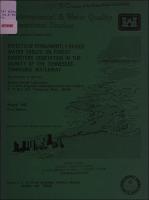Please use this identifier to cite or link to this item:
https://hdl.handle.net/11681/3023Full metadata record
| DC Field | Value | Language |
|---|---|---|
| dc.contributor | United States. Army. Corps of Engineers. Mobile District | - |
| dc.contributor | Environmental and Water Quality Operational Studies (U.S.) | - |
| dc.contributor.author | Klimas, Charles V. | - |
| dc.date.accessioned | 2016-03-15T20:26:56Z | - |
| dc.date.available | 2016-03-15T20:26:56Z | - |
| dc.date.issued | 1982-08 | - |
| dc.identifier.uri | http://hdl.handle.net/11681/3023 | - |
| dc.description | Miscellaneous Paper | - |
| dc.description | Abstract: Water tables are expected to rise somewhat in the vicinity of planned impoundments along the Tennessee-Tombigbee Waterway. Where permanent flooding of timber is anticipated, tree mortality is expected and has been accounted for in the project planning process. However, where water table levels will be raised significantly but permanent flooding does not occur, the effects on forests are very unclear. This report identifies factors that may be pertinent in assessing this type of impact. The information presented here has been drawn from the scientific literature on species flood tolerance and related topics that provide insight on potential water table effects. This review concentrates on induced mortality and changes in growth rates of mature trees. Raised water tables can detrimentally affect trees primarily by causing oxygen depletion in the root zone. The ability of an individual tree to withstand this type of stress may be related to a variety of factors, including the tree species, rooting depth, soil conditions, and the timing, duration, and frequency of encroachment of the water table into the root zone. In some situations, trees may show improved growth as a result of raised water tables, although this response may be short- lived. The forest communities likely to be most sensitive to partial root-zone saturation are those typically found on well-drained upland sites. Where such communities are subjected to drastic changes in the root environment, mortality may be widespread and rapid. In contrast, swamp forest communities (cypress-tupelo) are generally much less sensitive to increases in site moisture status, and may be affected primarily with respect to long-term growth and reproduction, or not at all. The complex floodplain forest (bottomland hardwood) communities present the greatest difficulty in predicting potential impacts resulting from raised water tables. Possible effects range from near-complete mortality in areas where permanent surface saturation occurs to no effect or growth rate increases in response to very minor, subsurface water table rises. The complexity of this issue suggests that only very general impact predictions may be possible except in areas where extreme stresses are anticipated. | - |
| dc.publisher | Environment Laboratory (U.S.) | - |
| dc.publisher | Engineer Research and Development Center (U.S.) | - |
| dc.relation | http://acwc.sdp.sirsi.net/client/en_US/search/asset/1040540 | - |
| dc.rights | Approved for public release; distribution is unlimited. | - |
| dc.source | This Digital Report was created from scans of the Print Resource | - |
| dc.subject | Forests | - |
| dc.subject | Forestry | - |
| dc.subject | Vegetation | - |
| dc.subject | Water tables | - |
| dc.subject | Plants | - |
| dc.subject | Tennessee-Tombigbee Waterway | - |
| dc.subject | Environmental effects | - |
| dc.subject | Environmental aspects | - |
| dc.subject | Water quality | - |
| dc.title | Effects of permanently raised water tables on forest overstory vegetation in the vicinity of the Tennessee-Tombigbee Waterway | - |
| dc.type | Report | en_US |
| Appears in Collections: | Miscellaneous Paper | |
Files in This Item:
| File | Description | Size | Format | |
|---|---|---|---|---|
| MP-E-82-5.pdf | 6.73 MB | Adobe PDF |  View/Open |